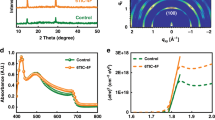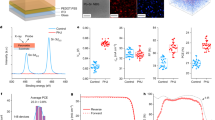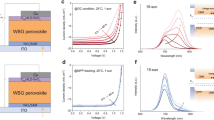Abstract
Perovskite solar cells (PSCs) have emerged as an attractive photovoltaic technology thanks to their outstanding power conversion efficiency (PCE). Further improvement in the device efficiency is limited by the recombination of the charge carriers in the perovskite layer even when employing heterojunction-based architectures. Here, we propose and demonstrate a p-type perovskite/n-type perovskite homojunction whose built-in electric field promotes oriented transport of the photo-induced carriers, thus reducing carrier recombination losses. By controlling the stoichiometry of the perovskite precursors, we are able to induce n-type or p-type doping. We integrate the homojunction structure in a planar PSC combining a thermally evaporated p-type perovskite layer on a solution-processed n-type perovskite layer. The PSC with a MAPbI3 homojunction achieves a PCE of 20.80% (20.5% certified PCE), whereas the PSC based on a FA0.15MA0.85PbI3 homojunction delivers a PCE of 21.38%. We demonstrate that the homojunction structure is an effective approach, beyond existing planar heterojunction PSCs, to achieve highly efficient PSCs with reduced carrier recombination losses.
This is a preview of subscription content, access via your institution
Access options
Access Nature and 54 other Nature Portfolio journals
Get Nature+, our best-value online-access subscription
$29.99 / 30 days
cancel any time
Subscribe to this journal
Receive 12 digital issues and online access to articles
$119.00 per year
only $9.92 per issue
Buy this article
- Purchase on Springer Link
- Instant access to full article PDF
Prices may be subject to local taxes which are calculated during checkout






Similar content being viewed by others
Data availability
The data that support the plots within this paper and other findings of this study are available from the corresponding author upon reasonable request.
References
Yang, W. S. et al. High-performance photovoltaic perovskite layers fabricated through intramolecular exchange. Science 348, 1234–1237 (2015).
Li, X. et al. A vacuum flash-assisted solution process for high-efficiency large-area perovskite solar cells. Science 353, 58–62 (2016).
Saliba, M. et al. Incorporation of rubidium cations into perovskite solar cells improves photovoltaic performance. Science 354, 206–209 (2016).
Cho, K. T. et al. Highly efficient perovskite solar cells with a compositionally engineered perovskite/hole transporting material interface. Energy Environ. Sci. 10, 21–627 (2017).
Yang, W. S. et al. Iodide management in formamidinium-lead-halide–based perovskite layers for efficient solar cells. Science 356, 1376–1379 (2017).
Kojima, A., Teshima, K., Shirai, Y. & Miyasaka, T. Organometal halide perovskites as visible-light sensitizers for photovoltaic cells. J. Am. Chem. Soc. 131, 6050–6051 (2009).
Best Research-Cell Efficiencies Rev. 01-03-2019 (NREL, 2019); https://www.nrel.gov/pv/assets/pdfs/pv-efficiency-chart.20190103.pdf
Anyi, M. et al. A hole-conductor-free, fully printable mesoscopic perovskite solar cell with high stability. Science 345, 295–298 (2014).
Fu, F. et al. Low-temperature-processed efficient semi-transparent planar perovskite solar cells for bifacial and tandem applications. Nat. Commun. 6, 8932 (2015).
Johnston, M. B. & Herz, L. M. Hybrid perovskites for photovoltaics: charge-carrier recombination, diffusion,and radiative efficiencies. Acc. Chem. Res. 49, 146–154 (2016).
Stranks, S. D. et al. Electron–hole diffusion lengths exceeding 1 micrometer in an organometal trihalide perovskite absorber. Science 342, 341–344 (2013).
Dong, Q. et al. Electron–hole diffusion lengths > 175 μm in solution-grown CH3NH3PbI3 single crystals. Science 347, 967–970 (2015).
Green, M. A., Jiang, Y., Soufiani, A. M. & Ho-Baillie, A. Optical properties of photovoltaic organic–inorganic lead halide perovskites. J. Phys. Chem. Lett. 6, 4774–4785 (2015).
Shi, D. et al. Low trap-state density and long carrier diffusion in organolead trihalide perovskite single crystals. Science 347, 519–522 (2015).
Miyata, A. et al. Direct measurement of the exciton binding energy and effective masses for charge carriers in organic–inorganic tri-halide perovskites. Nat. Phys. 11, 582–587 (2015).
Jeon, N. J. et al. Solvent engineering for high-performance inorganic–organic hybrid perovskite solar cells. Nat. Mater. 13, 897–903 (2014).
Chen, H. N. et al. Solvent engineering boosts the efficiency of paintable carbon-based perovskite solar cells to beyond 14%. Adv. Energy Mater. 6, 1502087 (2016).
Ahn, N. et al. Highly reproducible perovskite solar cells with average efficiency of 18.3% and best efficiency of 19.7% fabricated via Lewis base adduct of lead(II) iodide. J. Am. Chem. Soc. 137, 8696–8699 (2015).
Jeon, N. J. et al. Compositional engineering of perovskite materials for high-performance solar cells. Nature 517, 476–480 (2015).
Yang, Z. et al. Effects of formamidinium and bromide ion substitution in methylammonium lead triiodide toward high-performance perovskite solar cells. Nano Energy 22, 328–337 (2016).
Kim, H. S. et al. Lead iodide perovskite sensitized all-solid-state submicron thin film mesoscopic solar cell with efficiency exceeding 9%. Sci. Rep. 2, 591 (2012).
Liu, M., Johnston, M. B. & Snaith, H. J. Efficient planar heterojunction perovskite solar cells by vapour deposition. Nature 501, 395–398 (2013).
Chiang, C. H. & Wu, C. G. Bulk heterojunction perovskite–PCBM solar cells with high fill factor. Nat. Photon. 10, 196–200 (2016).
Son, D. Y. et al. Self-formed grain boundary healing layer for highly efficient CH3NH3PbI3 perovskite solar cells. Nat. Energy 1, 16081 (2016).
Bi, D. et al. Polymer-templated nucleation and crystal growth of perovskite films for solar cells with efficiency greater than 21%. Nat. Energy 1, 16142 (2016).
Zheng, X. et al. Defect passivation in hybrid perovskite solar cells using quaternary ammonium halide anions and cations. Nat. Energy 2, 2017102 (2017).
Jiang, Q. et al. Enhanced electron extraction using SnO2 for high-efficiency planar-structure HC(NH2)2PbI3-based perovskite solar cells. Nat. Energy 2, 16177 (2016).
Burschka, J. et al. Sequential deposition as a route to high-performance perovskite-sensitized solar cells. Nature 499, 316–319 (2013).
Wei, D. et al. TiO2 embedded structure for perovskite solar cells with anomalous grain growth and effective electron extraction. J. Mater. Chem. A 5, 1406–1414 (2016).
Wang, K., Liu, C., Du, P., Zheng, J. & Gong, X. Bulk heterojuntion perovskite hybrid solar cells with large fill-factor. Energy Environ. Sci. 8, 1245–1255 (2015).
Ye, S. et al. A strategy to simplify the preparation process of perovskite solar cells by co-deposition of a hole-conductor and a perovskite layer. Adv. Mater. 28, 9648–9654 (2016).
Wu, Y. et al. Perovskite solar cells with 18.21% efficiency and area over 1 cm2 fabricated by heterojunction engineering. Nat. Energy 1, 16148 (2016).
Kim, J., Lee, S. H., Lee, J. H. & Hong, K. H. The role of intrinsic defects in methylammonium lead iodide perovskite. J. Phys. Chem. Lett. 5, 1312–1317 (2014).
Yin, W. J., Shi, T. & Yan, Y. Unusual defect physics in CH3NH3PbI3 perovskite solar cell absorber. Appl. Phys. Lett. 104, 063903 (2014).
Wang, Q. et al. Qualifying composition dependent p and n self-doping in CH3NH3PbI3. Appl. Phys. Lett. 105, 163508 (2014).
Lyubov, A. F., Nadezhda, N. D. & Pavel, A. T. The chemical origin of the p-type and n-type doping effects in the hybrid methylammonium-lead iodide (MAPbI3) perovskite solar cells. Chem. Commun. 51, 14917 (2015).
Benedikt, D. Perovskite–perovskite homojunctions via compositional doping. J. Phys. Chem. Lett. 9, 2770–2775 (2018).
Ran, C., Xu, J., Gao, W., Huang, C. & Dou, S. Defects in metal triiodide perovskite materials towards high-performance solar cells: origin, impact, characterization, and engineering. Chem. Soc. Rev. 47, 4581–4610 (2018).
Song, D. et al. Managing carrier lifetime and doping property of lead halide perovskite by postannealing processes for highly efficient perovskite solar cells. J. Phys. Chem. C 119, 22812–22819 (2015).
Cui, P. et al. Highly efficient electron‐selective layer free perovskite solar cells by constructing effective p–n heterojunction. Solar RRL 1, 1600027 (2017).
Mali, S. S. & Hong, C. K. p–i–n/n–i–p type planar hybrid structure of highly efficient perovskite solar cells towards improved air stability: synthetic strategies and the role of p-type hole transport layer (HTL) and n-type electron transport layer (ETL) metal oxides. Nanoscale 8, 10528–10540 (2016).
Miyano, K., Tripathi, N., Yanagida, M. & Shirai, Y. Lead halide perovskite photovoltaic as a model p–i–n diode. Acc. Chem. Res. 49, 303–310 (2016).
Gil-Escrig, L., Miquel-Sempere, A., Sessolo, M. & Bolink, H. J. Mixed iodide-bromide methylammonium lead perovskite-based diodes for light emission and photovoltaics. J. Phys. Chem. Lett. 6, 3743–3748 (2015).
Sessolo, M., Momblona, C., Gil-Escrig, L. & Bolink, H. J. Photovoltaic devices employing vacuum-deposited perovskite layers. MRS Bull. 40, 660–666 (2015).
Liu, Y., Sun, Y. & Rockett, A. A new simulation software of solar cells—wxAMPS.Sol. Energy Mater. Sol. C 98, 124–128 (2012).
Song, D. et al. Dual function interfacial layer for highly efficient and stable lead halide perovskite solar cells. J. Mater. Chem. A 4, 6091–6097 (2016).
Bergmann, V. W. et al. Real-space observation of unbalanced charge distribution inside a perovskite-sensitized solar cell. Nat. Commun. 5, 5001 (2014).
Jiang, C. S. et al. Carrier separation and transport in perovskite solar cells studied by nanometre-scale profiling of electrical potential. Nat. Commun. 6, 8397 (2015).
Xiao, C. et al. Junction quality of SnO2-based perovskite solar cells investigated by nanometer-scale electrical potential profiling. ACS Appl. Mater. Interfaces 9, 38373 (2017).
Acknowledgements
This work is supported partially by the National Natural Science Foundation of China (grant no. 51772096), the Natural Science Foundation of Beijing Municipality (L172036), Joint Funds of the Equipment Pre-Research and Ministry of Education (6141A020225), the Par-Eu Scholars Program, the Science and Technology Beijing 100 Leading Talent Training Project, the Beijing Municipal Science and Technology Project (Z161100002616039), the Fundamental Research Funds for the Central Universities (2016JQ01 and 2017ZZD02) and the NCEPU `Double First-Class' Graduate Talent Cultivation Program. We thank Z. Cheng, R. Xu and Z. Liu for KPFM measurements and analysis, and X. Han and Z. Li for high-resolution TEM measurements. P.C. acknowledges the scholarship from the China Scholarship Council and thanks G. Cao for fruitful discussions.
Author information
Authors and Affiliations
Contributions
M.L. supervised the project. P.C. and M.L. conceived and designed the experiments. P.C. and D.W. performed the main experiments and characterization, and wrote the manuscript. J.J. helped with device optimization and fabrication. H.H. helped with KPFM measurements. E.J. performed Hall measurements and analysed the data. T.W. performed the simulation with wxAMPs. P.C., D.W., J.J., H.H., E.J., S.D., T.W., W.W. and M.L. contributed to the data analysis, discussed the results and commented on the manuscript.
Corresponding author
Ethics declarations
Competing interests
The authors declare no competing interests.
Additional information
Publisher’s note: Springer Nature remains neutral with regard to jurisdictional claims in published maps and institutional affiliations.
Supplementary information
Supplementary Information
Supplementary Notes 1–3, Supplementary Figures 1–21, Supplementary Tables 1–6, Supplementary References.
Rights and permissions
About this article
Cite this article
Cui, P., Wei, D., Ji, J. et al. Planar p–n homojunction perovskite solar cells with efficiency exceeding 21.3%. Nat Energy 4, 150–159 (2019). https://doi.org/10.1038/s41560-018-0324-8
Received:
Accepted:
Published:
Issue Date:
DOI: https://doi.org/10.1038/s41560-018-0324-8
This article is cited by
-
Photogenerated outer electric field induced electrophoresis of organic nanocrystals for effective solid-solid photocatalysis
Nature Communications (2024)
-
Unveiling the surface-interface properties of perovskite crystals and pivotal regulation strategies
Nano Research (2024)
-
Deposited 2D/3D Perovskite Heterojunctions Though Vapor-Assisted Solution Process for Restraining Intermixing Between the Two Phases
Transactions on Electrical and Electronic Materials (2024)
-
Numerical Simulation and Design of All-Thin-Film Homojunction Perovskite/c-Si Tandem Solar Cells
Silicon (2024)
-
Orientated crystallization of FA-based perovskite via hydrogen-bonded polymer network for efficient and stable solar cells
Nature Communications (2023)



